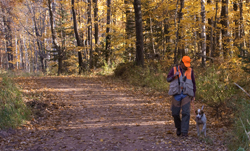Running grouse
Grouse run. Always have; always will.
… for the birds are such inveterate runners that unless they are bunched, running themselves en famille, in some southern nook, there will be no scent-cue wanting when once you have come near them.
~ Arthur Burdette Frost, Shooting Pictures magazine, 1895
More than 100 years later, Frost’s words still ring true. When a ruffed grouse is pursued by a bird dog and a hunter, they will run. They will run and run and run—and rarely in a straight line. In fact, I’ve known them to circle back behind their pursuers. Grouse also combine evasive tactics. They’ll run for a bit, then flush and fly some distance; then land and start running again.
The birds aren’t running randomly. They’re going to places where they’ve escaped pursuers many, many times before.
Running grouse pose a special challenge and provide the ultimate test for a pointing dog. Few have the knowledge, experience and talent to follow a running grouse as far as it takes to ultimately get the bird pointed. These special dogs—perhaps less than 10% of all pointing dogs—don’t just run through the woods looking for a grouse. Instead they are constantly seeking even the vaguest trace of grouse scent, maybe long after the bird moved through the area. Once the dogs get a whiff, they have the ability to determine which way the grouse went, follow until they determine they’re close enough and then pin it.
The expertise necessary to follow a running grouse isn’t acquired in one season. It might take two years, three years or even more. But when the dog finally puts it all together and, more often than not, takes on the king of the woods on the bird’s home turf and outwits it, that is a real grouse dog.





